Fiberglass reinforced ABS
Product description
Enhanced ABS is a modified plastic that improves the performance of ABS (acrylonitrile butadiene styrene copolymer) by adding other components such as glass fiber, carbon fiber, etc. The following is a detailed introduction to enhancing ABS:
###Main features
1. * * Mechanical performance * *:
-Compared to pure ABS, reinforced ABS has significantly improved properties such as tensile strength, bending strength, elastic modulus, and rigidity. The improvement of these properties is usually proportional to the content of added reinforcing materials (such as glass fiber), but when the content exceeds a certain range (such as 40%), the performance may decrease.
-The tensile strength of glass fiber reinforced ABS can reach 58-80MPa, the bending strength is 83-93MPa, and the bending elastic modulus can reach 3.0-3.7GPa.
2. * * Thermal performance * *:
-The thermal deformation temperature of ABS is significantly increased, which means it can maintain stable performance at higher temperatures.
-The thermal deformation temperature (0.45MPa) of glass fiber reinforced ABS is usually between 85~95 ℃.
3. * * Dimensional stability * *:
-The linear expansion coefficient of ABS is significantly reduced, and the molding shrinkage rate is significantly reduced, thereby improving the dimensional stability and precision of the product.
-Compared with pure ABS, the molding shrinkage of reinforced ABS can be reduced to below 0.3%.
4. * * Other performance * *:
-The weather resistance has been improved, providing the possibility of outdoor use.
-The impact strength may decrease due to the addition of reinforcing materials, but this contradiction can be balanced by optimizing the formula and process.
###Preparation methods and processes
1. * * Fiber reinforcement * *:
-The commonly used material is glass fiber reinforced ABS (GFR-ABS).
-The preparation methods include single screw extrusion method and double screw extrusion method. During the preparation process, attention should be paid to the impact of factors such as resin properties, glass fiber content, length, and improving interfacial adhesion on product quality.
2. * * Inorganic filler filling * *:
-In addition to fiber reinforcement, inorganic fillers such as asbestos can also be used to fill ABS, forming reinforced (filled) ABS.
###Application field
-Glass fiber reinforced ABS is mainly used to manufacture products with higher requirements for material stiffness and dimensional accuracy, such as camera casings, sewing machine parts, electronics, electrical appliances, automotive components, etc.
-Asbestos reinforced (filled) ABS is mainly used for manufacturing industrial components such as pressure filter plates and ventilation equipment.
###Precautions
-When using reinforced ABS, appropriate reinforcement materials and formulas should be selected according to specific application scenarios to achieve optimal performance and economic benefits.
-During the preparation and processing of ABS, attention should be paid to controlling process parameters such as temperature and pressure to ensure product quality.
Recommended products


